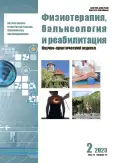The application of force plates and the community of experts in Russian dissertations for 2016–2022
- Authors: Kubryak O.V.1, Mezenchuk A.I.2, Pak S.A.2
-
Affiliations:
- National Research University Moscow Power Engineering Institute
- Research Center of Neurology
- Issue: Vol 22, No 2 (2023)
- Pages: 105-114
- Section: Review
- URL: https://journals.rcsi.science/1681-3456/article/view/251429
- DOI: https://doi.org/10.17816/430299
- ID: 251429
Cite item
Abstract
In 90 Russian dissertation studies with the usage of force plates, which were performed in 48 scientific organizations, more than 20 thousand healthy participants and patients took part. They were supervised by 89 specialists, who, together with 167 official opponents and representatives of 43 leading organizations, can be classified as the corps of experts in this scientific field. The appropriate list is presented for the first time.
Dissertation samples were distributed manly between clinical specialties (over 70%) and pedagogical specialties (approximately 20%). 14 different models (brands) of force plates were used in the dissertations. 6 of them were foreign, and the most frequently used ― in 55 dissertations ― were Russian force plates of three brands registered as medical devices, of which only one was an officially approved Measurement Device.
In the analysis of the data obtained using the force plates, the dissertators applied 30 quantitative indices, of which "length", "speed" and "area" of the statokinesiogram were the most frequently used.
The averaged characteristics of candidate and doctoral works in terms of the number of participants or patients included in the study, the number of sources, conclusions, etc. were represented. Interpretation of quantitative characteristics and content of dissertation works concerns comparison with the data of the analysis for the previous decade, and helps to reveal the features and the prospects of the stabilometry application.
Full Text
##article.viewOnOriginalSite##About the authors
Oleg V. Kubryak
National Research University Moscow Power Engineering Institute
Author for correspondence.
Email: o.kubryak@Lab17.ru
ORCID iD: 0000-0001-7296-5280
SPIN-code: 4789-2893
Dr. Sci. (Biol.)
Russian Federation, MoscowAnastasia I. Mezenchuk
Research Center of Neurology
Email: a.mezenchuk@Lab17.ru
ORCID iD: 0000-0002-7281-456X
Russian Federation, Moscow
Svetlana A. Pak
Research Center of Neurology
Email: s.pak@Lab17.ru
ORCID iD: 0009-0009-7188-9365
Student
Russian Federation, MoscowReferences
- Ivanova GE, Isakova EV, Krivoshei IV, et al. Consensus-building in the application of stabilometry and biofeedback by support reaction. Bulletin Rehabilitation Medicine. 2019;(1):16–21. (In Russ).
- Verbecque E, Johnson C, Rameckers E, et al. Balance control in individuals with developmental coordination disorder: A systematic review and meta-analysis. Gait Posture. 2021;83:268–279. doi: 10.1016/j.gaitpost.2020.10.009
- Bruyneel AV, Dubé F. Best quantitative tools for assessing static and dynamic standing balance after stroke: A systematic review. Physiother Can. 2021;73(4):329–340. doi: 10.3138/ptc-2020-0005
- Borzucka D, Kręcisz K, Rektor Z, Kuczyński M. Postural control in top-level female volleyball players. BMC Sports Sci Med Rehabil. 2020;12:65. doi: 10.1186/s13102-020-00213-9
- Saraiva M, Fernandes OJ, Vilas-Boas JP, Castro MA. Standing posture in motor and cognitive dual-tasks during smartphone use: Linear and nonlinear analysis of postural control. Eur J Investig Health Psychol Educ. 2022;12(8):1021–1033. doi: 10.3390/ejihpe12080073
- Kubryak OV, Krivoshey IV. Scientific field analysis based on the review of dissertation works. Monitoring of Public Opinion: Economic and Social Changes. 2016;(6):52–68. (In Russ). doi: 10.14515/monitoring.2016.6.04
- Kubryak OV. How technology precedes science (through the example of force plates). Gumanitarny vestnik. 2020;(2):1–13. (In Russ). doi: 10.18698/2306-8477-2020-2-656
- Neuman LW. Nonreactive research and available data. Sociological research. 1998;(6):119–129. (In Russ).
- Mueller A. Word Cloud for Python. 2020. Available from: https://github.com/amueller/word_cloud. Accessed: 06.01.2023.
Supplementary files








